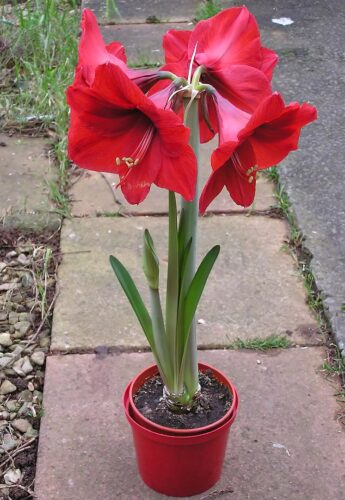Hippeastrum is a bulbous plant and family of the daffodil, there are about 70 species and countless hybrids and cultivars.
Also known as:
Amaryllis (old name)
Hippeastrum is a bulbous plant and belongs to the amaryllis family (Amaryllidaceae), there are about 70 species and countless hybrids and cultivars. There are some 70 species and numerous hybrids and cultivars. The origin of the Amaryllis, as this bulb is often called, is in the areas in and around Mexico and Argentina.
The bulbs are 3-11 cm in size. The bulbs develop an average of five long leaves. On the hollow flower stem come two or more large flowers. The vast majority of Hippeastrum specimens are grown as houseplants, but varieties are also grown for outdoor use in warmer climates – climate zone 8.
There are special vases in which Hippeastrum can be grown (hydroponics), similar to growing hyacinths in vase.
The care of Hippeastrum during the first bloom, is simple. Water the plant twice a week and fertilize it every two weeks. Rotate the bulb every few days so that the stem does not grow to one side.
Moist soil is important for long-lasting flowering, but avoid letting the potting soil stay wet for a long time, as this will cause the bulb to rot. Keep the top half of the potting soil dry.
Keep pets away from the plant as all parts are poisonous. After flowering, cut off the stems with the spent flowers, but leave the leaves. Place the bulb with pot – leave the leaves on – in a sunny, warm spot in the garden or – better yet – in a greenhouse or conservatory. Only put them in the garden after mid-May, because Hippeastrum is not frost-resistant. The bulb grows, new leaves appear. After summer, in late September, move the Hippeastrum to a cool spot(+10°C ) in the house or greenhouse. The bulb goes dormant and, like tulips and daffodils, the Hippeastrum needs a “winter” period to bloom. During this period, the bulb needs little water. After about eight weeks (early November), the leaves wither and new leaves emerge. This is the time to repot the bulb: plant the bulb in a wider pot with fresh soil (mixture of 1/3 clay, 1/3 sand and 1/3 compost). Do not plant the bulb into the earth up to the top: let a quarter of the bulb protrude above the earth. Then the bulb with pot can be placed in a warm place (20°C or more). Heat will cause the bulb to grow and rebloom.
Bugs
Deformed leaf: aphid. You often see the leaf
Only for outdoor cultivation: the bu
Fungi & diseases
Small pointed infestations in the tips of unfurling leaves. Red discolorations appear around the affected spots: Narcissus leaf scorch ( Peyronellaea curtisii). Initially, the infestations look like frost damage.
The bulb turns dark brown at the roots, sometimes grey. The bulb softens and between the skirts is white or pink fungus. Usually the infestation is not seen until the bulbs have been stored for some time: bulb rot (Fusarium oxysporum).
Care
The Hippeastrum failed to bloom after summer and dormancy: the summer was too wet and cold, so the bulb did not gain enough strength. In a pot that is too small, the Hippeastrum will also not flower.
Leaves start to droop: Hippeastrum is sensitive to stress. For example, forgetting to water them, moving them frequently or moving them too quicklytunnel cold to warm environments and vice versa.
Yellowed leaves, stunted growth and a softened bulb: too much water.

